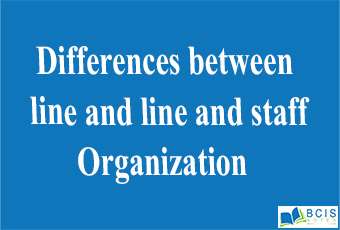
Differences between line and line and staff Organization
Line organizational structure is one of the simplest types of organizational structures. Its authority flows from top to bottom. Unlike other structures, specialized and supportive services do not take place in these organizations. The chain of command and each department head has control over their departments.
Line-staffs organization in management, approach in which authorities establish goals and directives that are then fulfilled by staffs and other workers. In a highly centralized structure, decisions are made by a few executives or managers and flow downward through the enterprise.
Perhaps the most important (and obvious) difference between line and staff is the purpose : line’s purpose is to work directly toward organisational goals, whereas staff advises and assists. Another important difference is authority. Line authority is generally considered as the formal (legitimate) authority created by the organisational hierarchy.
The Differences between line and line and staff Organization are about the meaning, authority, discipline, executives, degree of centralization, etc. They are explained below.
| BASIS FOR COMPARISON | LINE ORGANIZATION | LINE AND STAFF ORGANIZATION |
|---|---|---|
| Meaning | The organization in which the authority and responsibility move downward and accountability flows upward. | The organization structure, in which a specialist is added to the line managers to provide guidance and support. |
| Authority | Command | Command and Advise |
| Discipline | Strict | Loose |
| Executives | Line executives are generalist. | Line executives are generalist and staff executives are specialist. |
| Degree of centralization | Absolute centralization | Partly centralized and partly decentralized |
| Appropriate for | A small organization with less number of employees. | A large organization with a number of employees. |
you may also like Committee Organization

Leave a Reply